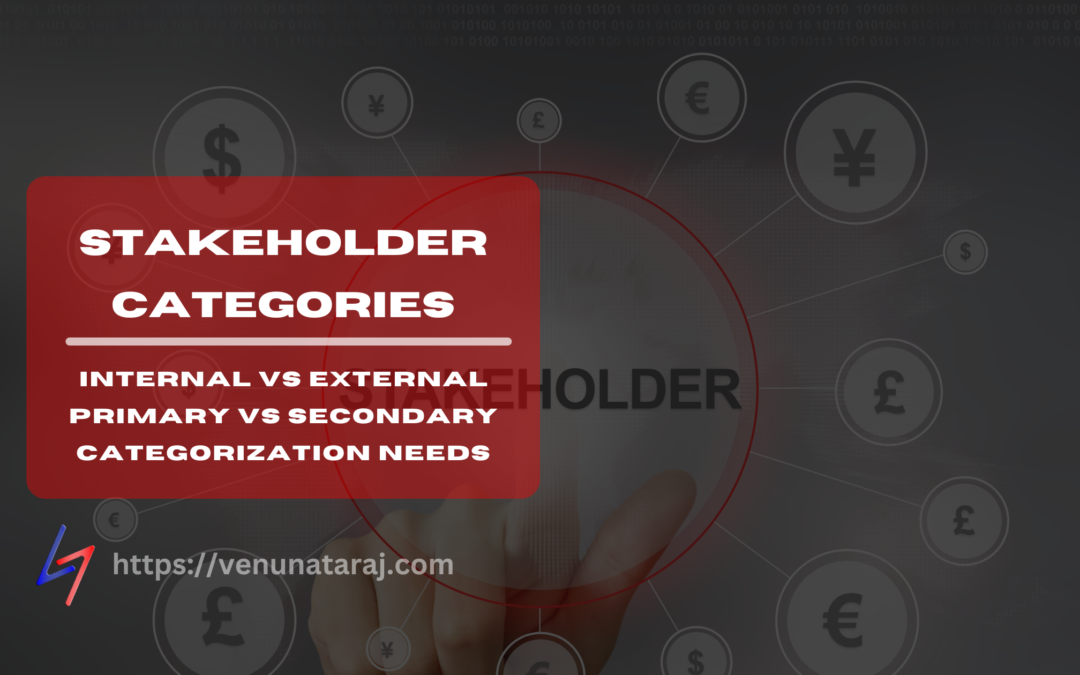Table of Contents
Decoding Stakeholder Categories: A Guide for Project Managers
From the project management’s perspective, understanding stakeholder categories is a critical aspect that often receives insufficient attention. This categorization serves as a valuable tool for project success. Let’s explore the various types of stakeholders and their significance in project management.
Understanding Stakeholders
A stakeholder is defined as any individual or group with a vested interest in the project’s outcome. The involvement of these parties can significantly influence the project, either positively or negatively. Therefore, identifying and effectively managing them is essential for ensuring the project’s success.
Two Primary Methods of Stakeholder Categorization
Stakeholders are typically categorized in two main ways:
- By Type: Internal vs. External Stakeholders
- By Impact: Primary vs. Secondary Stakeholders
Let’s examine each of these categories in detail.
Internal vs. External Stakeholders
Internal Stakeholders
Internal stakeholders are individuals or groups within the organization who have a direct stake in the project. This category typically includes:
- Project Managers: Those responsible for leading the project
- Project Team Members: Individuals involved in day-to-day project activities
- Executives and Senior Management: Those providing strategic direction and resources
- Resource Managers: Individuals responsible for allocating necessary resources
- Internal Customers: Departments or individuals within the organization who will utilize the project’s deliverables
Significance: Internal stakeholders are crucial as they are directly involved in the project and often have the most immediate impact on its success.
External Stakeholders
External stakeholders are individuals or groups outside the organization who have an interest in the project. This category typically includes:
- Customers and End Users: Those who will ultimately use the project’s output
- Suppliers and Vendors: Entities providing goods or services for the project
- Government Agencies: Regulatory or compliance bodies
- Local Communities: Individuals or groups potentially affected by the project
- Investors and Sponsors: Those providing financial support for the project
Significance: External stakeholders can significantly influence the project, even without direct involvement in day-to-day operations. Their satisfaction is often crucial for long-term project success.
Primary vs. Secondary Stakeholders
Primary Stakeholders
Primary stakeholders are those directly affected by the project outcomes and are essential for its success. This group often includes:
- Project team members
- Clients or customers
- End-users of the project deliverables
- Project sponsors
- Key decision-makers within the organization
Significance: Primary stakeholders are typically the top priority, as their satisfaction often directly correlates with project success.
Secondary Stakeholders
Secondary stakeholders are indirectly affected by the project and can influence it, but are not as critical as primary stakeholders. This group might include:
- Media outlets
- General public
- Activist groups
- Industry associations
- Competitors
Significance: While not the top priority, secondary stakeholders can still impact the project. Neglecting them entirely could lead to unexpected challenges.
The Importance of Stakeholder Categorization
Categorizing stakeholders offers several benefits:
- Tailored Communication: Enables more effective communication strategies for different stakeholder groups
- Resource Allocation: Helps prioritize efforts towards primary stakeholders while maintaining appropriate engagement with secondary ones
- Risk Management: Assists in anticipating and planning for risks associated with different stakeholder groups
- Strategy Development: Informs the overall stakeholder management strategy, determining the level of engagement required for each group
- Conflict Resolution: Facilitates more effective navigation of conflicts by understanding the nature and interests of different stakeholder categories
Practical Application: A Case Study
Consider a project to construct a new community center. The stakeholders might be categorized as follows:
Internal Stakeholders:
- Project team
- City council (for a city-led project)
External Stakeholders:
- Local residents
- Construction contractors
Primary Stakeholders:
- Future users of the community center
- Project sponsor (e.g., the mayor)
Secondary Stakeholders:
- Local businesses near the construction site
- Environmental groups interested in the project’s impact
This categorization allows for a targeted approach to each group. For example, weekly meetings with the internal team, monthly updates for the city council, community forums for local residents, and a dedicated website for secondary stakeholders to stay informed.
Conclusion
Understanding and effectively categorizing stakeholders is not merely an academic exercise but a practical tool that can significantly enhance project management. By identifying who’s who in the stakeholder landscape, project managers can communicate more effectively, manage risks better, and increase the likelihood of project success.
Remember, stakeholders are not just entries on a list, but individuals and groups with genuine interests in your project. Effective categorization is the first step in building strong relationships that can drive your project towards success.
As you embark on your next project, take the time to map out your stakeholders. This initial investment in stakeholder categorization will likely yield substantial benefits throughout the project lifecycle.
Additional Reads:
Creating a Stakeholder Registry
Managing Difficult Stakeholders Virtually
Stakeholder Communication for Project Success
Stakeholder Management for Effective Project Risk Management

